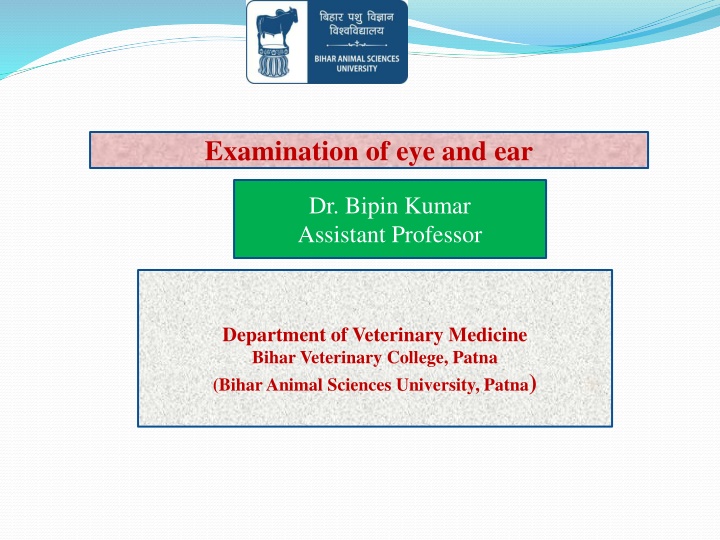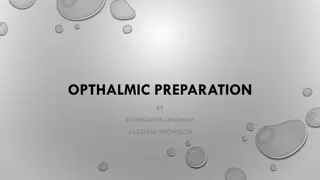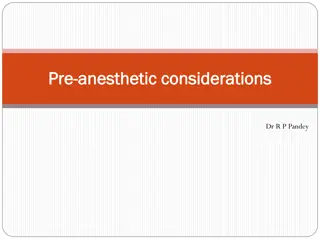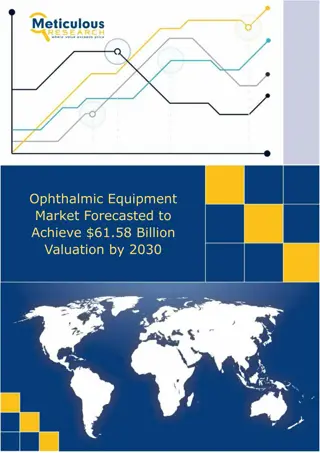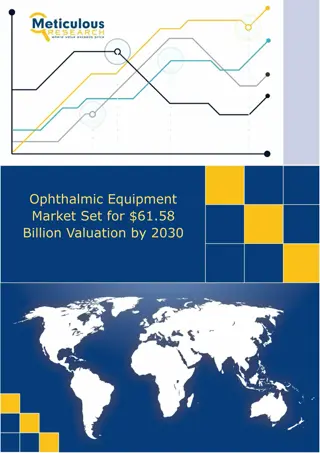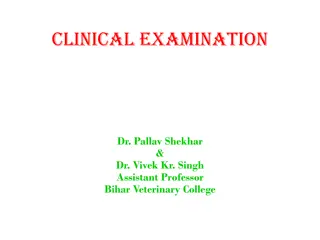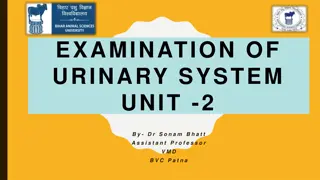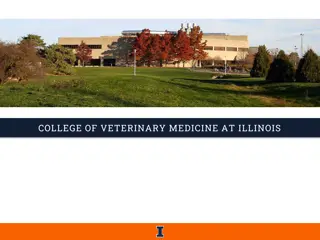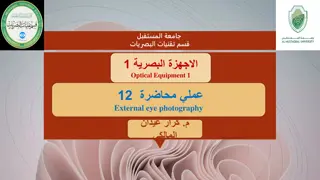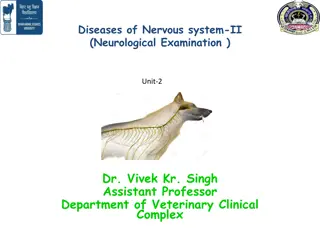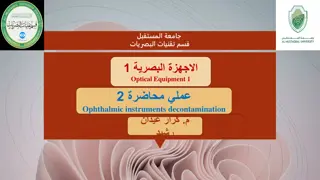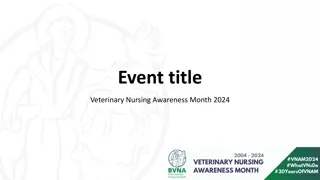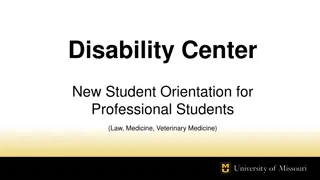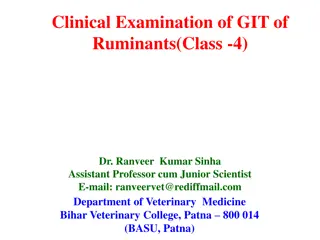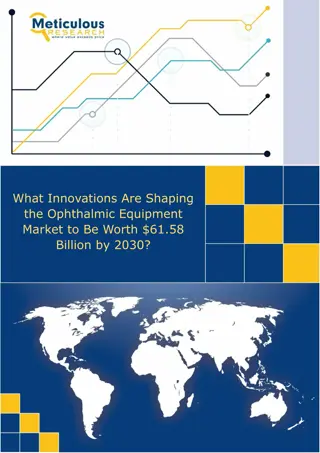Comprehensive Guide to Ophthalmic Examination in Veterinary Medicine
A detailed guide on the ophthalmic examination of animals led by Dr. Bipin Kumar, Assistant Professor at the Bihar Veterinary College. The examination covers history taking, general physical examination, evaluation of vision, pupil function, eyelid function, adnexal and anterior segment examination, and posterior segment examination. Detailed procedures and key points for each aspect of the examination are outlined, providing valuable insights for veterinary professionals.
Download Presentation

Please find below an Image/Link to download the presentation.
The content on the website is provided AS IS for your information and personal use only. It may not be sold, licensed, or shared on other websites without obtaining consent from the author.If you encounter any issues during the download, it is possible that the publisher has removed the file from their server.
You are allowed to download the files provided on this website for personal or commercial use, subject to the condition that they are used lawfully. All files are the property of their respective owners.
The content on the website is provided AS IS for your information and personal use only. It may not be sold, licensed, or shared on other websites without obtaining consent from the author.
E N D
Presentation Transcript
Examination of eye and ear Dr. Bipin Kumar Assistant Professor Department of Veterinary Medicine Bihar Veterinary College, Patna (Bihar Animal Sciences University, Patna)
OUTLINE 1. History and general physical examination 2. Evaluation of vision, pupil function, and eyelid function 3. Adnexal and anterior segment examination a. Schirmer tear test b. Vital stains c. Tonometry 4. Posterior segment examination a. Direct ophthalmoscopy b. Indirect ophthalmoscopy
History and General Physical Examination A complete and thorough history. Common presenting client complaints for ocular disease include pain, ocular rubbing, ocular discharge, vision changes, pupil abnormalities, ocular opacities, and ocular color changes. It is essential to identify all concurrent known systemic diseases and systemic abnormalities. All ocular and systemic pharmaceuticals received by the animal should be identified, including over-the-counter medications and medications administered by the client on their own accord. A complete physical examination is warranted for all animals presented for an ocular complaint, including evaluation of body temperature, thoracic auscultation, oral cavity examination, regional lymph node palpation, and abdominal palpation.
Evaluation of Vision, Pupil Function, and Eyelid Function The ophthalmic examination begins with observation of the animal at a distance. Signs of reduced vision or ocular discomfort (blepharospasm or ocular rubbing) can often best be appreciated from a distance prior to manipulation. Note how the animal navigates within the examination room. Skull and periocular structures are examined for size and symmetry. Additionally, the size, position, and movement of the globes are assessed. Assessment of vision may be performed by the menace response, cotton ball test, visual placing, dazzle reflex, and obstacle courses. The pupils are evaluated in light and dark environments for size, shape, and symmetry. Direct and indirect pupillary light reflexes are then tested with a bright, focal light source. Palpebral reflexes are tested by lightly touching nasally and temporally to the eyelids and observing the elicited blink response.
Adnexal and Anterior Segment Examination Schirmer tear test (STT). The periocular regions are visually examined and palpated for abnormalities including discharge, redness, alopecia, swelling, and atrophy. Eyelids and eyelid margins are examined for position, confirmation, movement, and other abnormalities (e.g., masses, alopecia, abnormal cilia). The nictitating membrane is assessed by gently retropulsing the globe through the upper eyelid to cause its elevation. The palpebral and bulbar conjunctiva, and the nictitating membrane are evaluated for color, thickness, inflammation, foreign bodies, masses, and other abnormalities. The sclera, visible under the bulbar conjunctiva, is examined concurrently for abnormalities of color and thickness. Assessment of the corneal tear film and corneal epithelial integrity can then be performed by application of corneal vital stains (e.g., sodium fluorescein, rose bengal, or lissamine green)
The anterior chamber is evaluated for transparency, depth, and abnormal contents (e.g., hyphema, hypopyon, fibrin, masses). Iris color, position, and appearance are assessed, including pupil size and shape. A complete evaluation of the lens can only be performed following pharmacologic dilation of the pupil. Prior to installing a mydriatic (typically 1% tropicamide), the intraocular pressure (IOP) must be evaluated by tonometry.
Posterior Segment Examination The posterior segment of the eye includes the vitreous, retina, choroid, and optic nerve. Examination of the posterior segment may be performed following pharmacologic dilation of the pupil by direct or indirect ophthalmoscopy. Direct ophthalmoscopes consist of a power source and coaxial optic system. Light is directed into the animal's eye and reflected back through a lens in the ophthalmoscope to the examiner. Direct ophthalmoscopes contain a rheostat to adjust light intensity, color filters, slit beams, grid beams, and a series of lenses to adjust the dioptric power (depth of focus within the eye). The image produced by a direct ophthalmoscope is real, erect, and magnified several fold. Disadvantages of the direct ophthalmoscope include the short working distance, small field of view (it is easier to overlook lesions and the examination is more time consuming), lack of stereopsis (depth perception), and greater distortion when the visual axis is partially opaque.
Indirect ophthalmoscopy is a technique performed with a light source and placement of a converging lens between the examiner's eye and the animal's eye. Indirect ophthalmoscopy generates an inverted and reversed image. Disadvantages of indirect ophthalmoscopy include less image magnification and greater clinician skill required to master the technique. Advantages of indirect ophthalmoscopy include the larger field of view, safer working distance, greater ease of examining the peripheral fundus, and shorter examination time. There are two basic types of indirect ophthalmoscopy: binocular and monocular.
